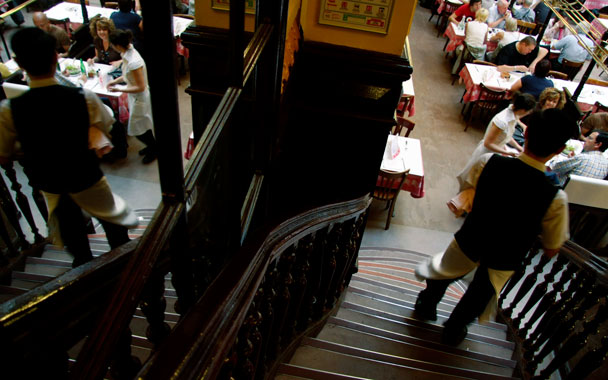The Avenue Trudaine is wide and stately, as beautiful as any of the grand streets of Paris, but it's only three blocks long, a boulevard to nowhere. It's hidden at the top of the 9th, just one street away from the busy Boulevard de Rochechouart, a real boulevard with traffic and a métro line. It also runs into the trendy Rue des Martyrs, easily one of the hippest shopping streets in Paris and one that is always packed. But the Avenue Trudaine is mostly empty, and some mornings I'll take one of the shaded sidewalk tables in front of Sole Caffe and join the expats reading the Guardian and the Gazzetta dello Sport.
If you go to Paris often enough, you stop working so hard to collect showstopping moments, and instead you start to appreciate the accidental beauty of places like the Avenue Trudaine. And, in fact, of this entire arrondissement.
One of the city's least-known neighborhoods, the 9th is also one of its most intimate. In recent years, it has become popular with bobos, who have been moving here to renovate airy apartments in pre-Haussmann buildings. But the gentrification isn't quite an invasion. True, if you have Sunday brunch at the Hôtel Amour, you'll see fashionably tousled couples ordering oeufs Bénédicte, and, like elsewhere in Paris, this area is home to a handful of tragically trendy bistros. But the 9th still has an appealing sleepiness, and even when a neighborhood spot gains an international reputation, like the tiny Rose Bakery, you can still find a seat in the back room and linger over a bowl of ricotta and lemon ice cream.
Rose Bakery might draw the stroller-and-scooter crowd from across the city, but the neighborhood's character is really found in the backstreets: in the guitar shops on the Rue Victor-Massé, in the philatelic auction houses on the Rue Drouot, in the Orthodox Jewish district around the Rue Richer, and in the prostitute-filled bars on the Rue Fontaine, which is also where you'll find Denise Acabo, a wood-paneled candy store where Madame Acabo, still wearing pigtails at an age when many would consider retiring, presides over glass cases stocked with exquisite confections.
And it's found in Spring, a 16-seat restaurant that's easily the most difficult reservation in Paris. It opened two years ago and almost immediately received the highest rating from the critic of Le Figaro. Other raves followed. The restaurant's formula is simple. There's a four-course set menu for $66, an inspired, affordable wine list, one waitress, and two cooks.
Olympe Versini, another neighborhood celebrity, was one of France's most important chefs in the 1970s, and one of the first women to earn a Michelin star. She closed her flagship restaurant in the late 1980s, then opened Casa Olympe—a cozy place on the nearby Rue Saint-Georges that vaguely reflects her Corsican roots and manages to be both sophisticated and homey—in 1993. It is just down the hill from the Place Saint-Georges, a small roundabout where the number 67 bus darts around a bust on a marble column. The figure, I found out from Peter Miller, an independent curator, is of Paul Gavarni, a lithographer and satirical cartoonist who was one of the most famous artists in Paris in the 1840s and who illustrated several Balzac novels. Miller, who now leads tours of the 9th, realized that many of the artists who interest him, such as Eugene Delacroix, had worked in the area.




 Pinterest
Pinterest


